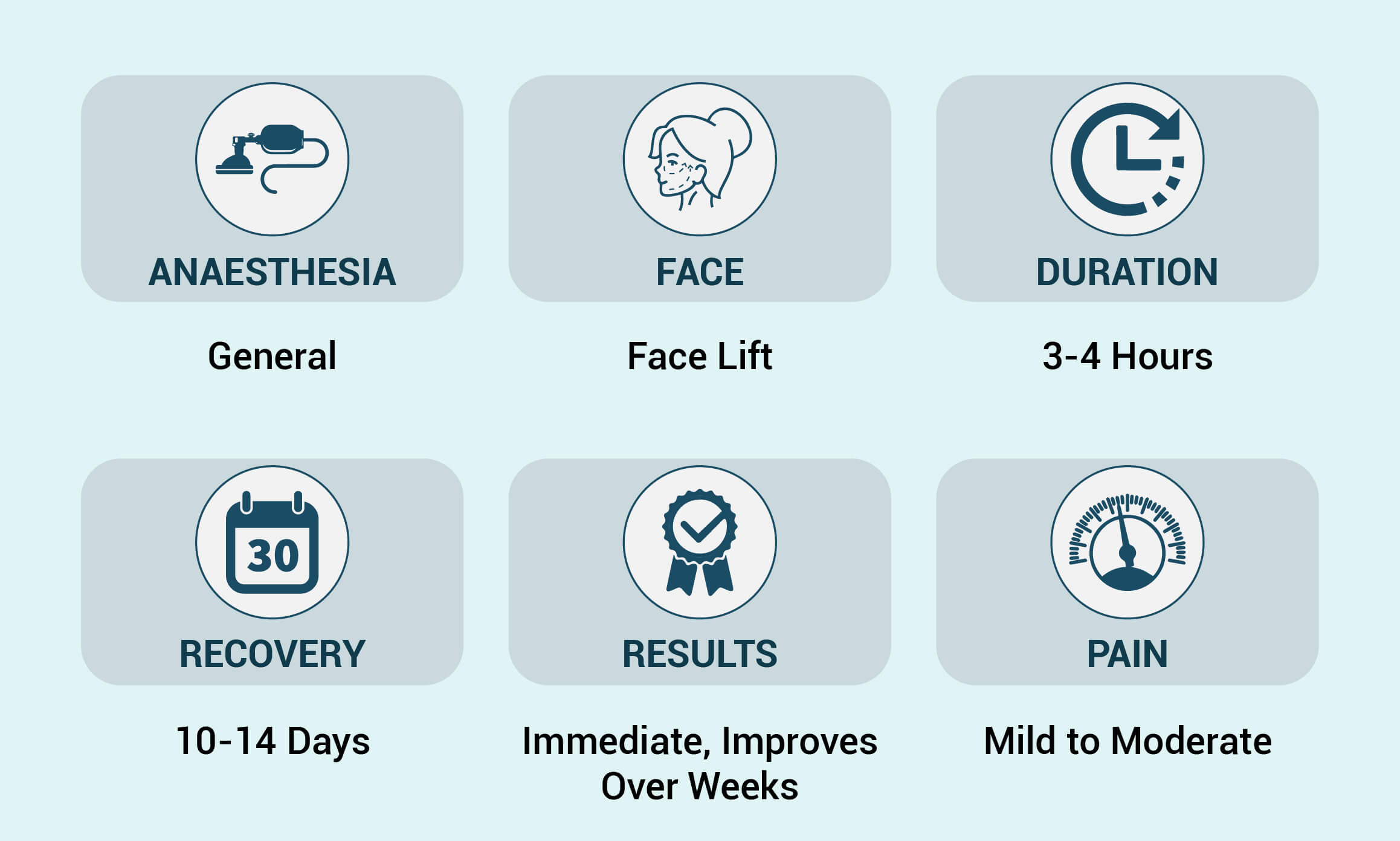Rhytidectomy - Face Lift Surgery in Mumbai
If you're considering face lifting surgery, it's important to understand the procedure, recovery process, and potential results. This comprehensive guide will provide you with all the information you need to make an informed decision about whether or not face lifting surgery is right for you.
Face Lift Surgery Overview
What is face lifting: Rhytidectomy or face lifting surgery is a cosmetic procedure that helps improve facial and neck aging signs.
Length of process: 2-6 hours
How long does the effect of facelift surgery last? : 4-6 weeks
Candidates suitable for Face Lift Surgery: People who experience sagging skin on their face and neck due to aging or weight loss.


What is face lifting surgery?
Rhytidectomy or face lifting surgery is a cosmetic procedure that helps improve facial and neck aging signs. It involves removing excess skin, tightening underlying tissues, and re-draping the skin to create a smoother and more youthful appearance.
The objective of facelifting surgery is to improve the natural characteristics of the face while preserving a natural appearance. This surgery can address issues such as sagging skin, deep wrinkles, jowls, and a double chin.
Types of face lifting surgery
Different types of facelift surgeries focus on specific facial areas and desired outcomes. The most common types of facelift surgery are:
Traditional facelift: The traditional facelift is the most frequently performed type of facelift surgery. It targets the lower face, jowls, and neck.
Mini facelift: This procedure is a less invasive alternative to the traditional facelift that focuses on the midface and lower face.
Midface lift: Facelift surgery that targets the cheeks and under-eye area is designed to address issues that occur with aging, such as sagging and hollowing.
Thread lift: If you're looking for a non-surgical alternative to traditional facelift surgery, there's an option available that involves inserting tiny threads or sutures under the skin to lift and tighten the tissue.
Neck lift: This type of surgery is focused on improving the appearance of the neck and jawline, which can often become loose or saggy as we age.
Preparing for surgery
Before undergoing facelift surgery, preparing yourself mentally and physically is essential. Here are some things to keep in mind:
Consultation: Consulting with a qualified and experienced plastic surgeon is essential. They will evaluate your medical history, examine your face, and discuss your expectations.
Medical clearance: Your surgeon might need medical clearance from your primary care physician to ensure you are fit for surgery.
Avoid smoking and drinking
Medications: Before your surgery, your surgeon may request that you discontinue taking specific drugs or supplements, such as aspirin, ibuprofen, or blood thinners, which can heighten the possibility of bleeding.
Arrange for help: You will need someone to drive you home after surgery and assist with household tasks and daily activities for a few days.
Prepare your home: To ensure a smooth recovery, it's best to stock up on groceries, prepare meals in advance, and create a comfy recovery area with pillows, blankets, and things to keep you entertained.
By following these guidelines, you can ensure that you are fully prepared for your facelift surgery and have a smoother recovery period.
Steps involved in facelift surgery
The facelift process typically involves the following steps:
Consultation: To start getting a facelift, you should book a consultation with a plastic surgeon specializing in this procedure. During the consultation, the surgeon will assess your face, review your medical history, and listen to your objectives and worries.
Anesthesia: Before the surgery, the patient will be given anesthesia. The choice between general or local anesthesia with sedation will depend on the patient's preference and the surgeon's advice.
Incisions: The surgeon will make inconspicuous incisions, typically in the hairline, around the ears, and occasionally beneath the chin.These incisions enable the surgeon to reach the underlying facial tissues.
Tissue repositioning: To achieve a younger look, the surgeon will adjust and move the skin, fat, and muscle of the face for a smoother appearance.
Skin removal: Skin removal
Closing incisions: After repositioning the tissues and removing excess skin, the surgeon will use sutures or staples to close the incisions.
Recovery: Following the surgery, the patient will stay in the recovery room until discharge. Recovery time is different for everyone but generally involves swelling, bruising, and discomfort lasting a few days to a few weeks.
Follow-up appointments: After the surgery, the surgeon will arrange follow-up visits to track the patient's recovery and ensure the incisions are healing correctly.
It is essential to mention various types of facelifts, such as traditional, mini, and mid-facelifts. The methods and procedures used may differ depending on the kind of facelift.
Duration of the surgery
The time it takes to complete a facelift surgery can range from two to six hours, depending on the specific technique and the procedure's extent. However, it's important to remember that the surgery's length may vary based on each patient's unique needs and desired outcome.
Anesthesia used during the surgery.
During facelift surgery, general or local anesthesia with sedation is used to ensure patient comfort.
Expected outcomes
The results of facelift surgery are immediate and continue to improve as the healing process progresses.
Facelift Surgery Recovery and Aftercare
Follow your surgeon's instructions: After your surgery, your surgeon will give you specific instructions for taking care of yourself.
Take a Rest.
Keep your head elevated: After surgery, it is essential to keep your head elevated, even while sleeping, for the first few days.This will help reduce swelling and promote healing.
Apply cold compresses: To reduce swelling and bruising after surgery, applying cold compresses to your face can be helpful.
Avoid smoking and alcohol
Keep your incisions clean: Keeping your incisions clean and dry is essential to prevent infection.
Attend follow-up appointments: To ensure proper healing and address any concerns or complications, attending all follow-up appointments with your surgeon is crucial.
What is the minimum age for facelift surgery?
There is no minimum age for facelift surgery, as it depends on individual factors such as skin elasticity and the extent of sagging skin.
How long does the effect of facelift surgery last?
The effect of facelift surgery varies from person to person but typically lasts 7 to 10 years.
Are there any non-surgical alternatives to facelift surgery?
Non-surgical alternatives to facelift surgery include injectables, such as Botox and dermal fillers, and skin tightening procedures like ultrasound and radiofrequency treatments.
Benefits of Face Lift Surgery
The effect of facelift surgery varies from person to person but typically lasts 7 to 10 years.
1.Provides a more youthful appearance
2.Boosts self-confidence and self-esteem
3.Reduces wrinkles, sagging skin, and fine lines
4.Improves facial contour and definition
5.Long-lasting results
6.Can be combined with other procedures for optimal results
7.Enhances overall facial appearance
8.Helps to look refreshed and rejuvenated
9.Can improve vision by lifting sagging skin around the eyes.
Candidates suitable for Face Lift Surgery
People who experience sagging skin on their face and neck due to aging or weight loss.
People who have deep lines or wrinkles on their face and neck
If you have experienced a loss of facial volume or notice a hollow look under your eyes or on your cheeks, we may be able to assist you.
People who have excess fat deposits in their face or neck, which can result in a double chin.
People who have realistic expectations about the outcome of the surgery and understand the risks involved
Generally, candidates should be in good health and not have any underlying medical conditions that could increase the risks of the surgery.
At The Plastic Surgeons, we understand the significance of regaining your youthful appearance and confidence. Our advanced face-lifting treatments are designed to achieve just that. With our skilled doctors, you can rest assured that your face-lifting journey will be in the hands of experienced professionals.
 WhatsApp
WhatsApp